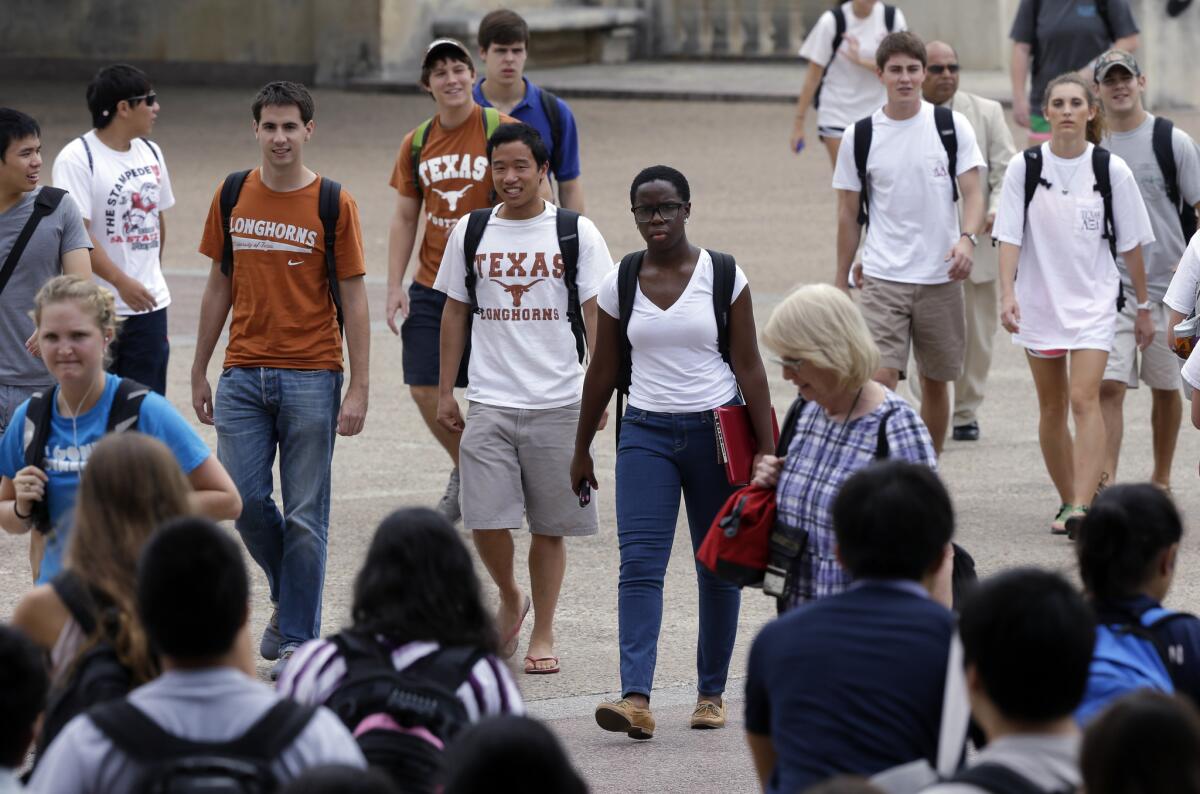A high-stakes battle for higher education

- Share via
There are good reasons the Wednesday argument before the Supreme Court in the case called Fisher vs. University of Texas has prompted more than the usual amount of speculation about the intentions of the justices and the case’s likely outcome. For higher education and, we believe, American society at large, the stakes could not be higher.
Abigail Fisher’s claim that the University of Texas unconstitutionally considered race in assembling its incoming undergraduate class — resulting, she argues, in her exclusion from the student body — reengages one of the most consequential legal and moral debates in American history.
In addition, the presence of procedural grounds for declining to hear the case, combined with a past statement by Chief Justice John G. Roberts Jr. questioning the propriety of affirmative action to achieve educational diversity, have emboldened advocates opposed to these policies.
And finally, the precedent at issue comes from Grutter vs. Bollinger, a Supreme Court ruling only nine years old, and one carrying the highly unusual suggestion from the majority opinion’s author, Justice Sandra Day O’Connor, that this 2003 decision affirming the essential value of diversity in higher education should have a 25-year life span.
Yet largely lost in the pre-argument discussion is what a decision overturning Grutter vs. Bollinger would mean for colleges and universities and the many other institutions of our civic and economic life that have embraced the ruling and benefited from it. Experience shows that underrepresented minority students in American colleges and universities would decline significantly and the costs would be substantial.
We know this based on the impact of a 1996 California ballot initiative barring any consideration of race in admissions policies in the state’s public higher education system; two years later, the number of African American, Latino and Native American freshmen attending UCLA and UC Berkeley had fallen by more than 50%, and the rates at which underrepresented minority students applied, were admitted and enrolled had declined at every UC campus. The reasons are complex, reflecting performance gaps on standardized tests, vestigial effects of racial discrimination and the sharp inequality of educational opportunity in our nation’s increasingly resegregated public schools.
For many Americans, mindful of slavery, Jim Crow and other variants of racial bigotry, the cost described by the California experience (and now in several other states) is measured by the capable minority students who were not admitted to college. But for university and college leaders — and, not incidentally, for the requirements of the U.S. Constitution as defined by Grutter vs. Bollinger — the crucial issue is somewhat different. As we and many of our public and private peer universities argue in amicus briefs filed in Fisher, abandonment of the Grutter precedent would undermine the quality of education we can offer to all our students. And we should be very clear that a new constitutional interpretation will equally bind private colleges and universities, damaging the openness and diversity we know is an essential element of the academic experience.
Psychological research confirms the intuitively sensible conclusion that minorities in a variety of settings will expend sizable intellectual and emotional resources on gauging the likelihood of marginalization based on their identity. As a result, despite great skill and accomplishment, their performance and ability to thrive is threatened, whether in the case of the few older employees working at a youth-dominated Silicon Valley start-up, the handful of female players in a symphony orchestra or underrepresented minority students going to college with an overwhelming majority of white classmates. The surest way to dissolve this identity threat and the damage it imposes on the achievements and contributions made by minorities is for the minority to achieve critical mass, diminishing the risk of marginalization.
And, if we are to succeed in encouraging our students to appreciate the complexity of the modern world, to question their inherited assumptions and to understand that wisdom is found frequently in unexpected places, then a variety of viewpoints must not only be present on our campuses but also given voice. While identifying the critical mass of students producing this kind of rich educational culture is, to be sure, a challenging and inexact science, it has been essential to the excellence of American higher education. By recognizing the importance of student body diversity and sanctioning the consideration of race in a holistic approach to admissions, the Grutter decision authorized universities to apply their unique expertise in making this judgment.
In this era of rising economic inequality, arguments that colleges and universities should focus exclusively on income diversity have understandable appeal. We also are firmly committed to ensuring that the opportunity to pursue a college education is open to all regardless of family income. But the ability of this approach alone to produce a truly diverse student body is not supported, however, either by experience or by demographic reality. The right path forward, and the one embraced by Grutter, is to preserve the consideration of race — along with income diversity and many other factors — in the admissions process.
The value of educational diversity cannot be fully captured when viewed through the lens of constitutional law or social psychology, our respective fields of expertise. This issue must be viewed against the sweep of American history. For decades, public and private efforts to overcome discrimination and racial separation have been embraced by a broad cross-section of American society, including the U.S. military and corporate leaders. This consensus emerged from the landmark ruling in Brown vs. Board of Education and the irreversible changes it set in motion bringing the nation closer to its founding ideal of equality. The distance the United States has traveled in building a more integrated society is one of our nation’s greatest achievements, recognized with admiration by countries around the world confronting their own histories of racial and ethnic discord. American colleges and universities have been at the very heart of this transformation, and they must be allowed to remain there.
Lee C. Bollinger is president of Columbia University. As president of the University of Michigan, he led the litigation defending its law school and undergraduate admissions policies in the 2003 Supreme Court cases Grutter vs. Bollinger and Gratz vs. Bollinger. Claude M. Steele, dean of the Stanford University School of Education, is the author of “Whistling Vivaldi and Other Clues to How Stereotypes Affect Us.”
More to Read
A cure for the common opinion
Get thought-provoking perspectives with our weekly newsletter.
You may occasionally receive promotional content from the Los Angeles Times.










